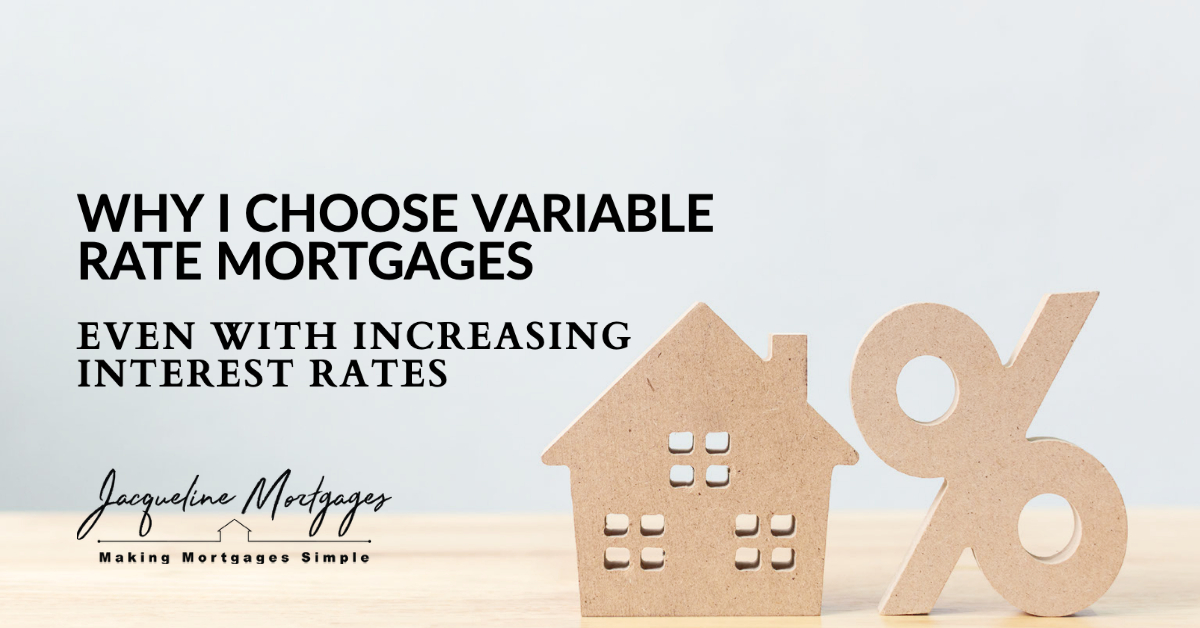
On March 2, 2022, the Bank of Canada increased their prime lending interest rate by 0.25%. And while this increase wasn’t a shock, it’s likely to be the first of a few increases this year. I am anticipating one more hike of 0.25% for 2022.
I have been busy answering tons of questions about this and upcoming increases. People are thinking about switching to a fixed-rate mortgage to save on interest rates. But, I’m going to share why I’m still pro variable rate mortgage, even with increasing rates.
Why A Variable Mortgage Is Still a Good Choice
I have always gone variable with my own mortgages. Historically, Variable Rate Mortgages (VRM) tend to save more money over the course of a term compared to a fixed-rate mortgage.
| Prime Rate Changes | Target Overnight Rate |
| May 31, 2010 | 0.50% |
| July 19, 2010 | 0.75% |
| September 7, 2010 | 1.00% |
| January 20, 2015 | 0.75% |
| July 14, 2015 | 0.50% |
| July 11, 2017 | 0.75% |
| September 5, 2017 | 1.00% |
| January 16, 2018 | 1.25% |
| July 10, 2018 | 1.50% |
| October 23, 2018 | 1.75% |
| March 3, 2020 | 1.25% |
| March 15, 2020 | 0.75% |
| March 26, 2020 | 0.25% |
| March 2, 2022 | 0.50% |
Let’s have a look at what the increase of 0.25% has on your mortgage payment for a variable mortgage:
Prime Prior to March 2
- Prior to March 2, Prime was at 2.45%
- A variable rate mortgage was Prime – 1% = 1.45%
If the principal balance on your mortgage is $300,000, the current principal and interest payment is $1,192.16. Approximately, $361.41 is the interest portion and $830.75 is the principal portion.
New Prime Rate After March 2
- New Prime Rate of 2.70%
- A variable rate mortgage is now 1.7%
Using the same principal balance of $300,000, your new principal and interest payment is $1,227.35. Approximately, $423.50 is the interest portion and $803.85 is the principal portion.
Change of $35.19 a month with a 0.25% increase of Prime on a $300,000 mortgage.
Let’s compare that payment to the payment of a current fixed-rate mortgage.
- Interest rate of 3.09% 5-year fixed rate
The same principal balance on a $300,000 mortgage. With the fixed interest rate, you’re principal and interest payment is $1,433.63. Approximately, $767.57 to the interest portion and $666.06 to the principal portion.
That payment is $206.28 higher than the payment with the increase in Prime!
Rates Are Still Going To Go Up
Here’s the thing, Prime is going to go up. Our inflation in Canada needs to be brought under control and the number one way the BOC can do this is by increasing interest rates. And, the rates will eventually go back up to pre-Covid times.
But, this is not a cause for worry! Even before Covid, I was still putting clients into variable-rate mortgages because it had the best cost savings. I have been one of those clients as well!
Even today, the lending rate is still 1.00% lower than it was prior to March 2020. Borrowers have enjoyed low-interest savings, especially with variable rates these past two years, and can continue to enjoy them!
I Have a Variable Rate Mortgage. What Are My Options?
My suggestion if you have a variable interest rate mortgage is to make slightly higher payments each month.
By prepaying more against your principal balance, if Prime does increase again, you already have that budgeted into your monthly spending. Because your principal is lower due to your increased payments, you would be paying less interest over time.
Prime rate is still incredibly low historically speaking, and the rates offered at prime less 1% or more for some of our clients mean this is still a very attractive rate.
Choosing Between a Fixed and Variable Rate Mortgage
Just keep in mind that no one can predict where interest rates are going to be with any certainty. What it comes down to is understanding what works for your budget.
- Payment Frequency – Make sure you are aware of the options available before deciding. Some lenders may not allow certain variations of payment frequency.
- Prepayment Options – Prepayment options are a great way to pay down the principal of your mortgage faster, but some lenders will limit how much you’re allowed to put down each year.
- Penalties – Do you think you’re going to break your mortgage before 3 or 5 years? A variable rate mortgage typically has a penalty of three months interest. Fixed-rate mortgages may have higher payment penalties determined by using a complicated formula called Interest Rate Differential.
- Conversion to Fixed Rate – If you stay with the same lender, you should be able to switch from a variable-rate to a fixed-rate mortgage with no penalty, however, the rate you pay may change.
At the end of the day, you don’t want to be paying more interest than you have to. That’s why having a mortgage expert on your team is so important! As I always say, let’s run the numbers and figure out how much money you can save in a variable-rate mortgage.
